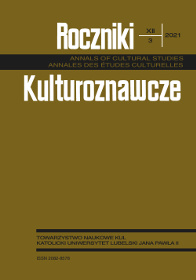Visual Metaphors of the COVID-19 Pandemic in Internet Memes
Abstract
The main goal of the article is to description of visual metaphors about the pandemic COVID-19 in Internet memes. The structure of the paper is a follows: in the first section, I consider the two basic theoretic components of this paper, i.e memes and visual metaphors which are relevant for further own analysis, then in the second section I present the methodology and detailed analyzes of ten selected examples of visual metaphors of a pandemic. Four issues are addressed: What are the two terms of the metaphor — source and target domain; Which term is the target domain of the metaphor, which is the source domain; What characters of the source domain are mapped to the target domain; What elements of primary mataphors can be found in the visualizations. The last part contains some concluding remarks.
References
Carroll, Noel. „Visual metaphor”. W: Aspects of Metaphor, red. Jaakko Hintikka, 189–223. Dordrecht: Kluwer, 1994.
Carroll, Noel. „A note on film metaphor”. W: Theorizing the Movie Image, red. Noel Carroll, 212–223. Cambridge: Cambridge University Press,1996.
Drozdowski, Rafał, i in. Życie codzienne wczasach pandemii. Raport z pierwszego etapu badań. Poznań: Wydział Socjologii UAM, 2020.
Eerden, Bart. „Anger in Asterix: The metaphorical representation of anger in comics and animate films”, w Multimodal metaphor, red. Charles Forceville, Eduardo Urios-Aparisi, 243–264. Berlin/New York: Mouton de Gruyter, 2009.
Fiut, Ignacy S. „Filozoficzne konsekwencje memetyki”. Racjonalista, dostęp 25.04.2020, http:// www. racjonalista.pl/ kk.php/t,4712.
Forceville, Charles. „Metaphors in pictures and multimodal representations”. W: The Cambridge Handbook of Metaphor and Thought, red. Raymond W. Jr. Gibbs, 462–482. Cambridge: Cambridge University Press, 2008.
Grady, Joseph. „A typology of motivation for conceptual metaphor: correlation vs. resemblance”. W: Metaphor in Cognitive Linguistics, red. Raymond W. Gibbs, Gerard Steen, 79–100. John Benjamins Publishing Company, 1999.
Grady, Joseph. „Primary metaphors as input to conceptual integration”. Journal of Pragmatics, nr 37 (2005): 1595–1614.
Hull, David. „Taking Memetics Seriously. Memetics Will Be What We Make It”. W: Darwinizing Culture: The Status of Memetics as a Science, red. Robert Aunger, 43–168. Oxford: University Press, 2000). DOI:10.1093/acprof:oso/9780192632449.001.0001.
Jezierska, Zuzanna. „Poznawcze i emocjonalne charakterystyki memów tworzonych w początkowym etapie pandemii koronawirusa w roku 2020”. Fabrica Societatis, nr 3 (2020): 190–200, dostęp 24.05.2021, www.fabricasocietatis.uni.wroc.pl. DOI: 10.34616/129172.
Kennedy, John M. „Metaphor in pictures”. Perception, nr 11(5) (1982): 589–605.
Kennedy, John M., Christopher D. Green i John Vervaeke. „Metaphoric Thought and Devices in Pictures”. Metaphor and Symbolic Activity, nr 8(3) (1993): 243–255.
Koller, Veronica. „Brand images: Multimodal metaphor in corporate branding messages”. W: Multimodal metaphor, red. Charles Forceville i Eduardo Urios-Aparisi, 45–71. Berlin/New York: Mouton de Gruyter, 2009.
Konstantineas, Charalambos, i Georg Vlachos. „Internet Memes: Humour in Late Modernity and Encroachment upon the Mainstream”, INTER-DISCIPLINARY.NET. A Global Network for Dynamic Research and Publishing, dostęp 20.04.2021, http://www.inter-disciplinary.net/critical-issues/wpcontent/uploads/2012/06/vlachosvispaper.pdf.
Krąpiec, Mieczysław A. „Analogia”. W: Wprowadzenie do filozofii. Lublin: Redakcja Wydawnictw KUL, 1992.
Libura, Agnieszka. Wyobraźnia w języku. Leksykalne korelaty schematów wyobrażeniowych, Wrocław: Centrum – Peryferie – Siły, 2000.
Nowak, Jakub. „Memy internetowe. teksty (cyfrowej) kultury językiem krytyki społecznej”. W: Współczesne media. Język mediów, red. Iwona Hofman i Danuta Kępa-Figura, 227–238. Lublin: Wydawnictwo Uniwersytetu Marii Curie-Skłodowskiej, 2013.
Phillips, Barbara J. „Understanding visual metaphor in advertising”. W: Presuasive Imagery. A Consumer Response Pespective, red. Linda M. Scott, Rajeev Batra, 297–310 Mahwah, NJ/London: Lawrence Erlbaum, 2003.
Shifman, Limor. „Memes in a Digital World. Reconciling with a Conceptual Troublemaker”, Journal of Computer-Mediated Communication, nr 18 (2013): 362–377.
Shinohara, Kazuko, i Yoshihiro Matsunaka. „Pictorial metaphors of emotion in Japanese comics”, w Multimodal metaphor, red. Charles Forceville, Eduardo Urios-Aparisi, 265–296, Berlin/ New York: Mouton de Gruyter, 2009.
Walkiewicz, Adam. „Czym są memy internetowe? Rozważania z perspektywy memetycznej”, Teksty z Ulicy. Zeszyt Memetyczny nr 12(2012): 50-69.
Whittock, Trevor. Metaphor and film. Cambridge, New York: Cambridge University Press, 1990.
Wiggin, Amy A., i Christine M. Miller. „Uncle Sam Wants You! Exploring Verbal-Visual Juxtapositions in Television Advertising”, w Presuasive Imagery. A Consumer Response Perspective, red. Linda M. Scott and Rajeev Batra,267-295. Mahwah, NJ/London: Lawrence Erlbaum, 2003.
Velasco, Marisol, i Pedro Fuertes. „Towards a critical cognitive-pragmatic approach to gender metaphors in Advertising English”, Journal of Pragmatics, nr 38(11) (2006): 1982-2002.
Velasco, Marisol, i Pedro Fuertes. „Olfactory and olfactory-mixed metaphors in print ads of perfumes”, Annual Review of Cognitive Linguistics, nr 4 (2006): 217-252
Ventola, Eija, Charles Cassiliy, i Martin Kaltenbacher. Perspectives on Multimodality. Amsterdam: Benjamins, 2004.





